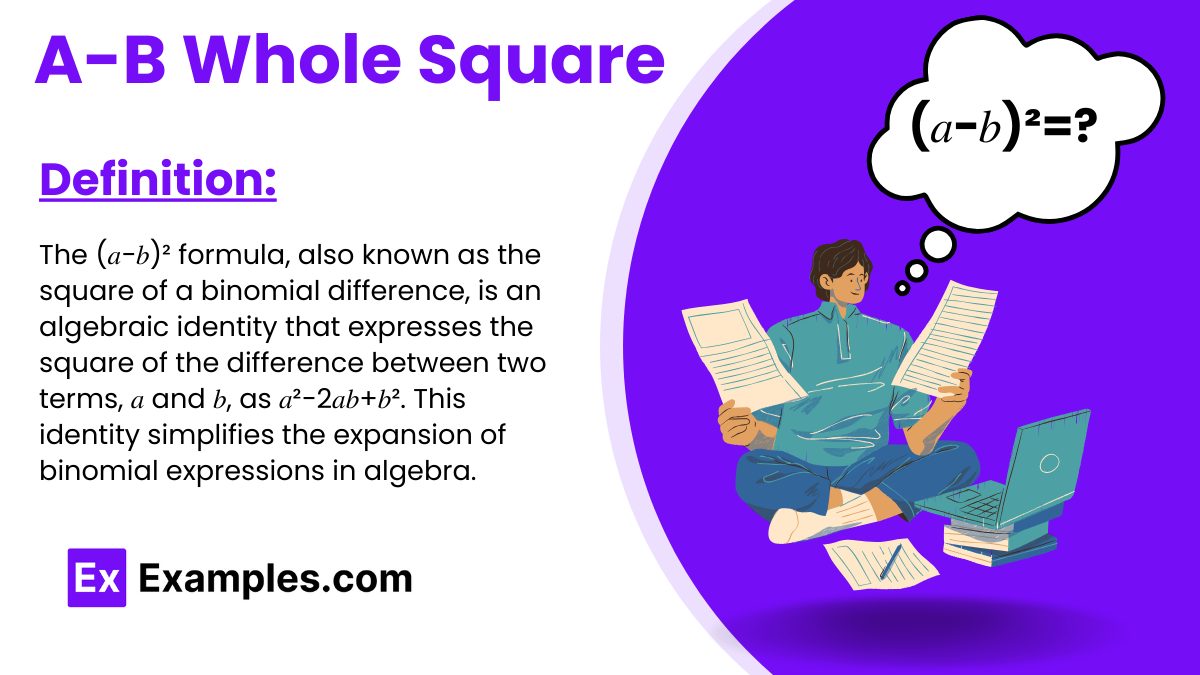Find the result of (5−3)².
1
2
4
16


The algebraic identity (𝑎−𝑏)² represents the square of the difference between two numbers, 𝑎 and 𝑏. This formula expands to 𝑎²−2𝑎𝑏+𝑏², integrating concepts from integers, rational numbers, and irrational numbers. It finds utility in various mathematical fields including algebra, where it helps simplify expressions and solve equations. The identity also plays a role in statistical methods like the least squares method, which is used for data fitting. Understanding (𝑎−𝑏)² is fundamental in exploring more complex numerical and algebraic studies, including square and square roots.
The formula for (𝑎−𝑏)², commonly referred to as the square of a binomial difference, is an important algebraic identity. It is expressed as:
This formula represents the expanded form of squaring the difference between any two numbers, 𝑎 and 𝑏. Here’s a breakdown of the components:

To prove the algebraic identity (𝑎-𝑏)² = 𝑎²-2𝑎𝑏+𝑏², we can use the method of expanding the expression through basic algebraic principles. Here’s the step-by-step proof:
Start with the expression (𝑎−𝑏)². This signifies the square of the binomial 𝑎−𝑏.
Remember that squaring a binomial involves multiplying the binomial by itself:
(𝑎−𝑏)² = (𝑎−𝑏)(𝑎−𝑏)
Now, combine all the terms from the expansion:
𝑎²−𝑎𝑏−𝑎𝑏+𝑏²
Combine the middle terms:
−𝑎𝑏−𝑎𝑏 = −2𝑎𝑏
So, the expression simplifies to:
𝑎²−2𝑎𝑏+𝑏²
This completes the proof that (𝑎-𝑏)² = 𝑎²-2𝑎𝑏+𝑏². This identity is very useful in algebra for simplifying expressions and solving equations, and it holds true for all real numbers, including integers, rational numbers, and irrational numbers.
The formula for (a−b)² is a fundamental algebraic identity used to expand and simplify expressions. The identity is:
(a−b)² = ab²−2ab+b²
This formula shows that the square of the difference between two terms, a and b, is the square of the first term, minus twice the product of the two terms, plus the square of the second term. Here are some examples to illustrate how to apply this formula in various scenarios:
Problem: Calculate (5−3)².
Solution: Using the formula:
(5−3)² = 5²−2⋅5⋅3+3² = 25−30+9 = 4
So, (5−3)² = 4.
Problem: Simplify (𝑥−4)2(x−4)2.
Solution: Apply the formula:
(𝑥−4)² = 𝑥²−2⋅𝑥⋅4+4² = 𝑥2−8𝑥+16
Thus, (𝑥−4)² simplifies to 𝑥²−8𝑥+16.
Problem: Expand (3𝑎−2𝑏)².
Solution: Using the identity:
(3𝑎−2𝑏)² = (3𝑎)²−2⋅3𝑎⋅2𝑏+(2𝑏)² = 9𝑎²−12𝑎𝑏+4𝑏²
So, (3𝑎−2𝑏)² expands to 9𝑎²−12𝑎𝑏+4𝑏².
In real-life, the (𝑎−𝑏)² formula can be used in project planning to calculate variances, in finance to compute financial forecasts and risk assessments, and in engineering to design and analyze the stability of structures. It also plays a role in optimizing processes and solving problems that involve squared differences.
The (𝑎−𝑏)² formula is crucial for simplifying and solving algebraic equations, aiding in data analysis (e.g., in statistical methods like the least squares method), and understanding geometric relationships. It’s a foundational tool in algebra that extends to various applications in higher mathematics and applied sciences.
The formula for (𝑎−𝑏)² is 𝑎²−2𝑎𝑏+𝑏². Here, 𝑎² represents the square of the first term, −2𝑎𝑏 is twice the product of the two terms and indicates subtraction, and 𝑏² is the square of the second term. This identity helps simplify and solve quadratic expressions in algebra.
Text prompt
Add Tone
10 Examples of Public speaking
20 Examples of Gas lighting
Find the result of (5−3)².
1
2
4
16
What is the value of (8−2)²?
24
36
48
64
If A = 7 and B = 4, what is (A−B)²?
9
11
15
16
Calculate (10−6)².
4
8
12
16
Find the expanded form of (3A − 2B)².
9A² − 12AB + 4B²
9A² + 4B² − 12AB
9A² − 6AB + 4B²
9A² − 4AB + 4B²
Find the result of (A−B)² when A = 9 and B = 4.
15
20
25
30
If A = 14 and B = 3, what is (A−B)²?
100
110
121
169
What is the expanded form of (4A − 2B)²?
16A² − 16AB+4B²
16A² + 4B² −16AB
16A² − 4AB + 4B²
16A² − 8AB + 4B²
Calculate (7 − 1)².
24
25
36
49
What is the expanded form of (A−B)²?
A² − B²
A² + B² − 2AB
A² − 2AB + B²
A² + 2AB + B²
Before you leave, take our quick quiz to enhance your learning!

